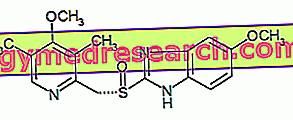
Generality
Esomeprazole is the S enantiomer of omeprazole, the progenitor of drugs belonging to the category of proton pump inhibitors.
The particular spatial orientation of the chemical structure of esomeprazole results in a reduction of the first-pass effect and favors the achievement of the site of action, resulting in a better inhibition of the proton pump compared to the other medicines belonging to this pharmaceutical category .
How it works

The blockade of hydrochloric acid secretion promoted by awesomeprazole is specific, dose-dependent and irreversible; esomeprazole, in fact, irreversibly binds to the enzyme H + / K + / ATPase, which is an integral part of the proton pump: this bond causes the blockage of hydrochloric acid secretion in the stomach until a new proton pump is synthesized .
The pharmacological inhibitory effect of esomeprazole on the proton pump appears one hour after oral administration; taking esomeprazole allows a rather constant and predictable pH control, which does not depend much on the subject and is therefore quite satisfactory.
Several clinical studies have shown that esomeprazole is more effective than other proton pump inhibitors - such as lansoprazole and pantoprazole - in the control of gastric hydrochloric acid secretion. At equivalent doses of esomeprazole, levogyri enantiometer, and racemic omeprazole the plasma concentrations of esomeprazole are much higher, of about 80-90%, because the latter undergoes a minor hepatic metabolism; consequently, to have the same degree of inhibition of acid secretion in the stomach, a lower dose of esomeprazole must be administered than that of omeprazole with therapeutic effect.
Posology and method of use
Precautions
Before prescribing a treatment with esomeprazole it is essential to make sure that the symptoms are not due to a neoplastic ulcer, especially if the subject complains of a sudden drop in body weight accompanied by hematemesis, dysphagia and recurrent vomiting; in fact, treatment with esomeprazole - alleviating the symptoms of this malignant disease - can delay and complicate the diagnosis.
In the case of subjects who are simultaneously taking proton pump inhibitors and statins, it is advisable to monitor signs and / or symptoms of a possible muscular toxicity, because the two classes of drugs administered together - due to the metabolic drug interactions - may increase the risk of myopathy, which can degenerate to rhabdomyolysis.
Esomeprazole In children
In the case of pediatric patients over the age of 12, esomeprazole is indicated only for the treatment of gastroesophageal reflux disease, while it is not recommended for the treatment of other diseases or for patients under 12 years of age.
Esophagitis
In the treatment of erosive esophagitis 40 mg / day of esomeprazole are used, taken in a single administration one hour before the meal, for 4-8 weeks; in the most serious cases the treatment can be repeated for another 4 weeks. The maintenance and prophylaxis dose of recurrences is 20 mg / day, to be taken always in a single administration, before the meal.
Gastroesophageal reflux disease
In gastroesophageal reflux disease, 20 mg / day of esomeprazole is used in a single administration, before a meal, for 4 weeks. If healing has not been completed, then a second course of therapy can be carried out for another 4 weeks; in the case of sporadic reappearance of symptoms, 20 mg / day of esomeprazole can be given as needed.
Zollinger-Ellison syndrome
In the treatment of Zollinger-Ellison syndrome the attack dose is 80 mg / day of esomeprazole, divided into two daily doses of 40mg; after which the optimal dose of the drug is identified based on the individual therapeutic response. The usual doses for this pathology can reach up to 160 mg / day, but doses equal to or greater than 80 mg / day should be divided into several daily administrations.
In case of liver failure
The maximum dose of esomeprazole to be used in patients with severely impaired liver function is 20 mg / day.
Contraindications and warnings
Drug interactions
Esomeprazole, like the whole class of proton pump inhibitors, is also metabolized by the large CYP450 family of enzymes, so special care must be taken when the active ingredient is administered simultaneously with other drugs metabolised in the same way. For example, one of the drugs to which particular attention should be given is clopidogrel ; Esomeprazole reduces the antiplatelet and cardioprotective activity of clopidogrel precisely because of the pharmacometabolic inhibition. In fact, from several studies on patients with cardiovascular problems, it was found that individuals treated with clopidogrel associated with a proton pump inhibitor undergo cardiovascular events more frequently than those taking only clopidogrel.
Phenytoin is another drug that interacts with esomeprazole when taken simultaneously; in particular, esomeprazole causes an increase in phenytoin plasma concentrations equal to about 13-14%.
Even Warfarin, when administered together with esomeprazole, increases its anticoagulant power; therefore, it is advisable to carefully monitor prothrombin time, especially if esomeprazole is taken discontinuously when needed.
Pregnancy and breastfeeding
Animal studies have shown no evidence of harm to the fetus during treatment with esomeprazole, although there are no adequate studies on animals or pregnant women who have shown any risk to the fetus during pregnancy. It is not known whether esomeprazole is excreted in breast milk, but the related studies have not shown any risk, or postnatal toxicity in breast-fed children of mothers receiving esomeprazole. In studies conducted on pregnant patients receiving omeprazole, of which esomeprazole is the S enantiomer, there was no risk of increased incidence of major malformations, abortions, premature births and ectopic pregnancies.
Side effects
The most frequent side effects of esomeprazole are gastrointestinal ones, such as diarrhea, nausea, vomiting and dry mouth. Among these, the most widespread in treated patients is diarrhea, which affects about 3% of subjects.
Other rather common side effects are the central ones, such as headache, dizziness, drowsiness, agitation and nervousness. There are also less frequent side effects such as dermatological (dermatitis, urticaria or pruritus), metabolic (hyponatremia) and muscoskeletal effects; the latter, such as muscle weakness, myopathy and rhabdomyolysis, are quite rare.



